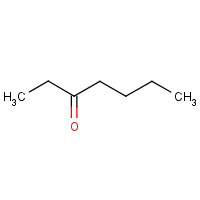Ethyl butyl ketone
Agent Name
Ethyl butyl ketone
Alternative Name
3-Heptanone
CAS Number
106-35-4
Formula
C7-H14-O
Major Category
Solvents

Synonyms
3-Heptanone; Aethylbutylketon [German]; Butyl ethyl ketone; Eptan-3-one [Italian]; Ethyl butyl ketone; Ethyl n-butyl ketone; Ethylbutylcetone [French]; Ethylbutylketon [Dutch]; Etilbutilchetone [Italian]; Heptan-3-on [Dutch, German]; Heptan-3-one; n-Butyl ethyl ketone; [ChemIDplus] UN1224
Category
Ketones (<C12)
Description
Colorless liquid with a powerful, fruity odor; [NIOSH]
Sources/Uses
Used as a fragrance and a solvent for resins and coatings; it occurs naturally in breads. [ACGIH]
Comments
Inhalation of high concentrations can cause CNS depression; A skin, eye, and respiratory tract irritant; [ICSC]
Biomedical References
Exposure Assessment
Skin Designation (ACGIH)
Insufficient data
TLV (ACGIH)
50 ppm
STEL (ACGIH)
75 ppm
PEL (OSHA)
50 ppm
MAK
10 ppm
IDLH (NIOSH)
1000 ppm
Excerpts from Documentation for IDLHs
Basis for original (SCP) IDLH: The chosen IDLH is based on the statements by Patty [1963] and Deichmann and Gerarde [1969] that 0 rats died following a 4hour exposure to 2,000 ppm, but 6 of 6 rats died following a 4hour exposure to 4,000 ppm [Smyth et al. 1949]. . . . Human data: None relevant for use in determining the revised IDLH.
Vapor Pressure
2.6 mm Hg
Odor Threshold Low
0.1 ppm
Odor Threshold High
10 ppm
Lethal Concentration
LCLo (rat) = 2,000 ppm/4H
Explanatory Notes
Odor threshold from "Quick Guide: The Electronic NIOSH Pocket Guide to Chemical Hazards"; Flash point = 46 deg C; VP from HSDB;
NFPA
high ambient temp required
Adverse Effects
Neurotoxin
Acute solvent syndrome
Diseases, Processes, and Activities Linked to This Agent
Diseases
Occupational diseases associated with exposure to this agent:
Processes
Industrial Processes with risk of exposure: